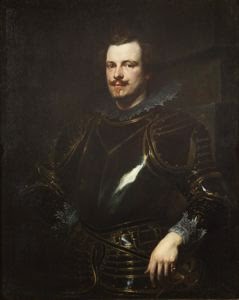de VOS: YOUNG MAN WITH A DOG
by Joan K. Yanni
Cornelis de Vos, painter of MAG's Young Man with a Dog, (55.83) was one of the foremost artists of his day. Patrons sought him out, Peter Paul Rubens referred commissions to him, and his good friend Anthony van Dyck painted a portrait of him. His paintings are well executed and beautifully detailed. He excelled in painting children and families.
His Young Man with a Dog is an early Baroque painting, with strong diagonals—the boy's arm gestures toward the dog's head, cutting across the canvas; the dog, in turn, looks up attentively at his master. The dog's left leg, poised above the ground, provides a lower diagonal. The billowing red Baroque drapery catches the viewer's attention and provides a background for the figures. To our left, the drape parts to reveal a slice of landscape probably owned by the boy's family. The boy's clothing is meticulously detailed.
It is worth noting that the name Count de Feria is inscribed on the back of the painting. It is not clear whether the inscription refers to the sitter or to an owner of the painting, but it is known that the name is one of Spanish nobility.
De Vos (1585-1651) was a painter of religious and historical subjects as well as portraits. A Flemish painter, he had studied with David Remeeus in Antwerp, then, around the age of twenty, traveled abroad. In 1608 he became a master in the Guild of St. Luke (the painter's guild) in Antwerp and served as dean in 1618-20. Though he had been born in Hulst, he bought Antwerp citizenship in 1616 in order to become an art dealer. About 1635 he became one of the many talented assistants of Rubens, who kept an extensive workshop of painters, specialists in various genres, to help him handle his tremendous number of commissions.
In addition to de Vos, many other painters in the MAG collection trained or collaborated in the Rubens workshop. These include Frans Snyders, known in his own right as a painter of animals (The Fable of the Fox and the Stork), landscape painter Joos de Momper (Landscape with Figures), Jacob Jordaens (Portrait of Elizabeth Jordaens, Daughter of the Artist), David Teniers the Younger (Tavern Scene), and Van Dyck (Portrait of an Italian Nobleman). Van Dyck, who went on to become painter for the English court of Charles I, was probably the most successful painter to come from Rubens' studio. Rubens' oil sketch, The Reconciliation of King Henry III and Henry of Navarre is also in the Gallery's collection.
Young Man with a Dog was part of the Bertha Buswell Bequest, one of the important sources of MAG European art. Mrs. Buswell, the wife of a Buffalo physician, was a collector of 17th-century Dutch, Flemish, and French works, including furniture, tapestries, sculptures and paintings. Some items she gave outright to the UR; others were left to her brother Ralph Hochstetter until his death and then were presented to the Gallery along with art from Hochstetter's own collection. Thus, some artworks are labeled Bertha Buswell Bequest, others Buswell-Hochstetter Bequest. Among paintings received from these bequests are Steen's The Pancake Woman, Teniers' Tavern Scene, Mae's Portrait of a Gentleman, van Santvoort's Portrait of Eva Bicker, de Bray's Child with Cherries, and many other works. The Buswell-Hochstetter Bequest came to the Gallery in 1955 and the entire collection was exhibited at the Gallery in November and December of that year.
On docent tours the de Vos painting can be compared with dell’Abate, Portrait of a Boy of the Bracciforte Family, Noah North’s Pierrepont Lacey and His Dog Gunn, Henri’s Tom Cafferty, and any of MAG’s 17th-century paintings.


No comments:
Post a Comment